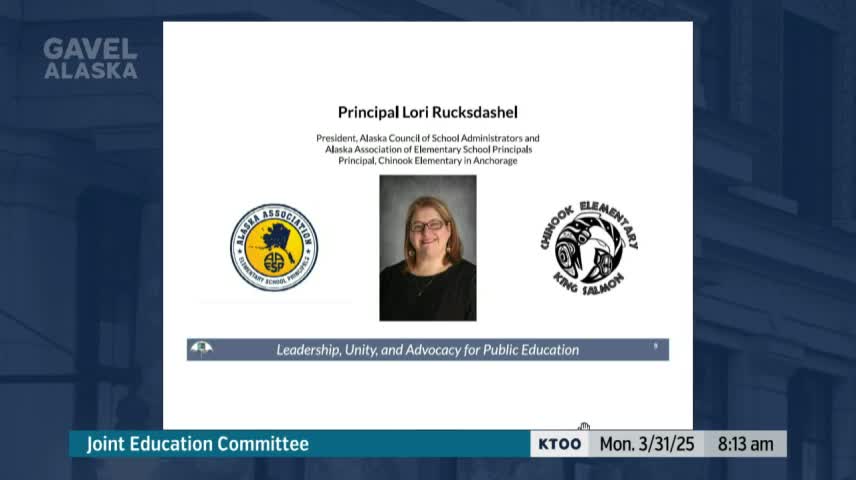Principals and administrators cite turnover costs, call for retirement solutions and mentoring to retain educators
March 31, 2025 | 2025 Legislature Alaska, Alaska
This article was created by AI summarizing key points discussed. AI makes mistakes, so for full details and context, please refer to the video of the full meeting. Please report any errors so we can fix them. Report an error »

Juneau, Alaska — School principals, superintendents and association leaders told a joint House–Senate education committee on March 31 that teacher and principal turnover is costly and that retirement benefits and mentorship are central to retention.
“According to the 2017 study by the Economic Policy Institute, the average teacher earns 26.4 percent less than other professionals with college degrees,” said Lori Rextaschel, principal of Chinook Elementary School and president of the Alaska Association of Elementary School Principals. She cited turnover costs and urged investment in retirement systems.
Rextaschel said turnover carries a measurable price. “Data from 2017 really shows the cost of teacher turnover. It is estimated that it costs $20,000 every time a teacher turns over,” she said. She also cited Wallace Foundation research that “the average cost to replace a principal is $75,000.”
Rextaschel called on legislators “to provide and fund a public pension system or a viable alternative retirement system that fairly compensates all district staff who devote many years to Alaska's children.” Lisa Paradis and other witnesses said many educators leave for the Lower 48 where pay and defined-benefit retirement systems are more competitive.
Panelists described programs aimed at improving retention. Rick Dormer, principal of Ketchikan High School and president of the Alaska Association of Secondary School Principals, outlined the Alaska School Leadership Academy (ASLA), a mentoring program for new principals that has expanded since 2018. Jennifer Rinaldi, principal lead for the Alaska School Leadership Academy, told the committee the program is a two-year induction with mentee retention varying because of turnover and other factors.
“Principals in the program do love the program, but again, we are within the constraints of not having a defined benefit, salaries and benefits, and that's a problem,” Rinaldi said.
Why it matters: Presenters tied turnover to student outcomes, noting that districts with lower turnover have higher proficiency rates. Witnesses recommended strengthening retirement benefits, expanding mentorship and making investments to reduce churn among teachers and administrators.
Ending: Association leaders asked for legislative attention to pension and compensation structures and reiterated ongoing mentoring and recruitment efforts.
“According to the 2017 study by the Economic Policy Institute, the average teacher earns 26.4 percent less than other professionals with college degrees,” said Lori Rextaschel, principal of Chinook Elementary School and president of the Alaska Association of Elementary School Principals. She cited turnover costs and urged investment in retirement systems.
Rextaschel said turnover carries a measurable price. “Data from 2017 really shows the cost of teacher turnover. It is estimated that it costs $20,000 every time a teacher turns over,” she said. She also cited Wallace Foundation research that “the average cost to replace a principal is $75,000.”
Rextaschel called on legislators “to provide and fund a public pension system or a viable alternative retirement system that fairly compensates all district staff who devote many years to Alaska's children.” Lisa Paradis and other witnesses said many educators leave for the Lower 48 where pay and defined-benefit retirement systems are more competitive.
Panelists described programs aimed at improving retention. Rick Dormer, principal of Ketchikan High School and president of the Alaska Association of Secondary School Principals, outlined the Alaska School Leadership Academy (ASLA), a mentoring program for new principals that has expanded since 2018. Jennifer Rinaldi, principal lead for the Alaska School Leadership Academy, told the committee the program is a two-year induction with mentee retention varying because of turnover and other factors.
“Principals in the program do love the program, but again, we are within the constraints of not having a defined benefit, salaries and benefits, and that's a problem,” Rinaldi said.
Why it matters: Presenters tied turnover to student outcomes, noting that districts with lower turnover have higher proficiency rates. Witnesses recommended strengthening retirement benefits, expanding mentorship and making investments to reduce churn among teachers and administrators.
Ending: Association leaders asked for legislative attention to pension and compensation structures and reiterated ongoing mentoring and recruitment efforts.
View full meeting
This article is based on a recent meeting—watch the full video and explore the complete transcript for deeper insights into the discussion.
View full meeting
